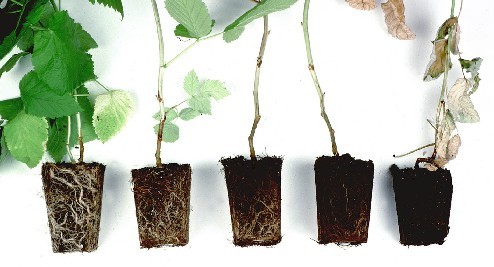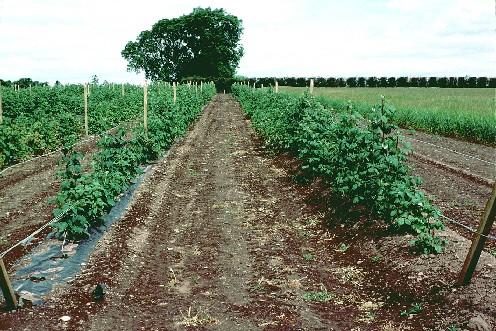Control
Phytophthora spp. produce resting oospores that can remain viable in soil for many years. Thus, replanting raspberries into contaminated soil is very likely to result in a recurrence of the disease. Oospores germinate to release motile zoospores that are readily carried in soil water and thus spread the disease within the crop. The prevention of new outbreaks can be achieved by ensuring that the planting material is free of disease, combined with avoiding fields with known or recent root rot problems, or planting in soil where raspberries have never been grown previously and the fungus is not likely to exist.
However, there is a continuing need for additional control measures. Field trials of integrated control of raspberry root rot (Dolan & Duncan 1997) drew the following conclusions.
- Fungicidal control of raspberry root rot gives a partial level of control that may be more effective when combined with resistant cultivars and good husbandry within an integrated management strategy. Fungicides that were tested included Recoil (a.i.s mancozeb and oxadixyl) and alternatives to this product including Shirlan (a.i. fluazinam). Due to the withdrawal of Recoil, a 'Specific Off Label Approval' (SOLA) was obtained in 2003 for the use of Shirlan on raspberries.

Root rot trial
Root rot trial in which increasing applications of fungicide were assessed.
LHS=non-infected control; RHS=no fungicide; others=varying fungicide concentrations. - Developing improved levels of resistance in new raspberry selections would go a long way to greatly lessening the impact of the disease. To see what steps SCRI is taking to improve host-mediated resistance see below.
- Ridging alone to improve drainage and potentially lessen the rate of water-borne infection would have little economic impact on disease. Nevertheless, ridging is generally beneficial and it is recommended that growers include it in their management systems where root rot is a problem. Maintaining an increased ridge height was found to be beneficial and growers can and should take steps each year to ensure that ridges are not eroded away.
- Mulching with polythene had mixed effects in the trials and cannot be recommended to commercial growers on grounds of contributing to root rot control. It is expensive and prevents re-building of ridges, which generally slump over several years. It may, however, have a role in management of weeds and suckers thus assisting in stool management.

Treatments involving ridging and mulching in a root rot trial at The James Hutton Institute.
Since this work in the 1990s, a large proportion of the UK raspberry crop is now grown in a protected environment in which crop agronomy and management has changed greatly from traditional outside cropping. The move to protected cropping has not lessened the need to seek solutions to raspberry root rot, indeed it has increased the importance of the use of healthy planting stock, particularly for 'long cane' production. For more details of the high health scheme, see FruitHealth.
Resistance
Because of the limited options and difficulties of chemical control for raspberry root rot, host resistance offers the most promising means of controlling the disease. Although few sources of resistance are known, a strong quantitative form of resistance is known to exist in some cultivars (e.g. Latham) and the genetics of this are being investigated at The James Hutton Institute (see below). There are other potential sources of root rot resistance and if durable resistance is to be developed and effectively deployed some fundamental characteristics of the interaction need to be investigated. For example, it is not known if host resistance to P. fragariae var. rubi is also effective against other Phytophthora species, whether the resistance is durable across a variety of environmental conditions (e.g. in protected crops) and to the range of Phytophthora strains that exist both in the UK and internationally. Research in this area is intended to take place in the next few years at The James Hutton Institute.
Gene mapping in raspberry is at an early stage, but preliminary work has already shown the potential of the approach to map genes underlying a number of commercially important traits. Further mapping of disease resistance genes is underway, including identifying the gene(s) responsible for resistance to raspberry root rot (Graham & Smith 2002). Four regions across 4 linkage groups have been identified to be linked to resistance to root rot, and further research aimed at confirming these in a second population in glasshouse and field trials is underway (see the Rubus genomics section) in the FruitBreeding site.
References
- Dolan A & Duncan JM (1997) Field trials of integrated control of raspberry root rot. Final report to Scottish Soft Fruit Growers Ltd.
- Graham J & Smith K (2002) DNA markers for use in raspberry breeding. Acta Horticulturae 585:51-56.
